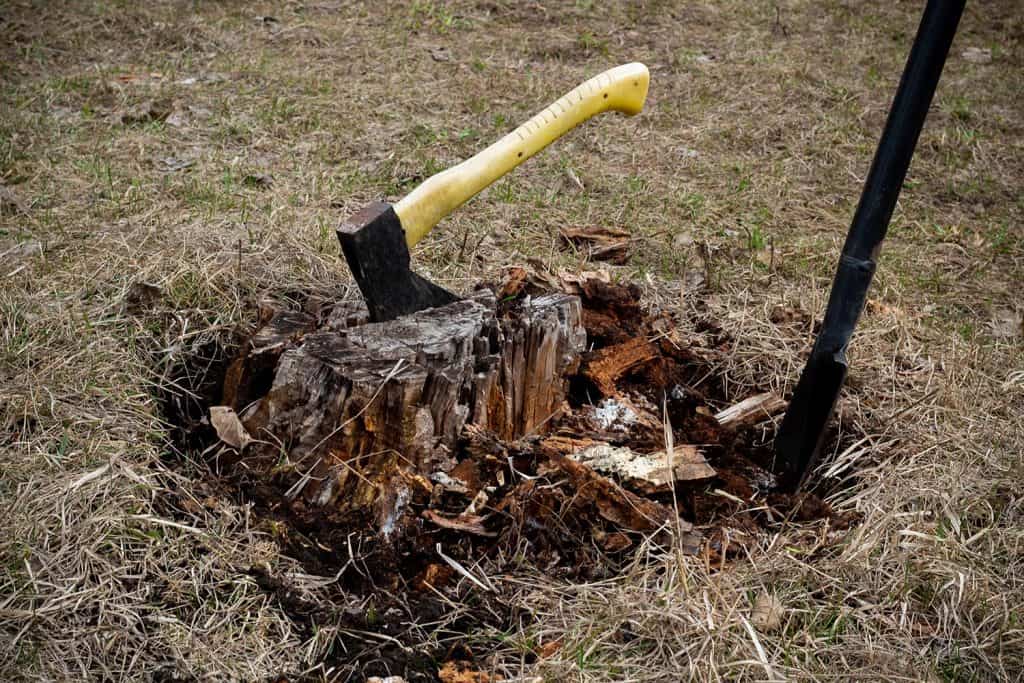Holly trees are popular plants due to their ornamental foliage and bright red berries. But sometimes the need arises to remove them from your landscaping. The tree itself is easy to cut down. However, the stump and roots are a little harder to remove. We’ve researched the best way to remove a holly tree stump and roots so that you can do it yourself by following our guide.
To remove a holly tree, stump, and roots, follow these steps:
- Wear protective clothing.
- Prune back the tree.
- Cut the tree down.
- Shovel around the stump.
- Separate and remove the roots and stump.
- Clean up.
As long as you have the proper tools, you can remove a holly tree fairly easily as long as you are willing to put the work in. In this guide, we’ll cover all of the information you need to know in order to remove a holly tree, as well as the stump and roots, from your yard. Please continue reading to learn more.

Why Remove A Holly Tree?
There are many reasons why you might want to completely remove a holly tree from your yard- stump, roots, and all. Some people may want to remove them for purely aesthetic purposes, but there are other underlying reasons as well.
Changing Your Landscaping
The first reason why you might want to remove a holly tree from your yard is that you are considering changing your landscaping. Landscaping has a major effect on your home’s curb appeal. The holly tree may not fit in with your new landscaping plans. Leaving the stump behind can be unsightly, so you may want to go ahead and remove it as well.
Disease Or Death
The second reason for removing a holly tree is due to disease or death. If the tree is diseased beyond repair, it is best to remove it from your lawn entirely. That includes the tree itself as well as the stump and roots. If you don’t, the disease could spread to other areas of your lawn. If the tree is completely dead, obviously you would want to remove it as well.
Invasive Roots
Holly trees have invasive root systems. The roots have a tendency to branch out to seek nutrients. By doing so, they can cause damage to structures and underground utilities such as plumbing. Even if they aren’t planted close to structures, the holly tree roots can interfere with the root systems of other plants, so it is best to remove as many of the roots as possible.
How To Remove A Holly Tree Stump And Roots

Now that you know why you might want to remove a holly tree, let’s look at how to go about doing that. Here are the tools that you’ll need:
- Protective clothing (gloves, long-sleeves, jeans)
- Loppers
- Chainsaw
- Shovel
- Axe
- Steel digging bar
1. Wear Protective Clothing
Before attempting to remove a holly tree, it is a good idea to wear protective clothing. The leaves of holly trees are sharp and can scratch and poke you during removal. At the very least, this could cause discomfort, but it could cause a more serious injury without proper protection.
It is a good idea to wear thick leather gloves, a long-sleeved shirt, and jeans. You may even choose to wear eye protection as well.
2. Prune Back The Tree
The first thing you will want to do is use the loppers to prune back the tree as much as possible. Not only will pruning the tree give you easier access to the main trunk, but it will also give you a safety blanket when you cut the tree down. There will be fewer branches that could potentially fall on you.
3. Cut The Tree Down
After pruning the tree, you will need to cut it down using the chainsaw. Remember to observe chainsaw safety and keep your hands and other body parts away from the moving blade. Wear safety goggles as well to keep sawdust out of your eyes.
Cut the tree so far down the trunk that there are only about six inches left exposed above the ground. This will make the stump less heavy when you remove it. Be sure to cut the tree in a way so that it falls away from you and any other structure such as a house, fence, or another tree.
4. Shovel Around The Stump
Depending on the size of it, your next step will be to use a shovel or spade to dig around the stump. The idea is to dig a trench that is deep enough to expose the roots. Be sure to pile up the dirt that you remove because you will need it later.
5. Separate And Remove The Roots And Stump
Once the roots are exposed, use the axe to chop them away from the stump. Remove the stump by placing a digging bar beneath the stump and prying it up. This will also help to break up any smaller roots. Then, remove any large roots that are still in the hole.
Click here to see this digging bar on Amazon.
6. Clean Up
Now that the stump and roots have been removed, it’s time to clean up. Begin by using the loose dirt you piled up to fill in the hole where the stump was. Then, you will need to remove the tree, stump, and roots. If you don’t, they will kill the grass.
The best way to remove them is to move them to a separate location and burn them. But if your area has burn restrictions in place and this isn’t an option, you will need to contact your local government to find another way to have them removed.
How Do You Kill A Holly Tree Stump?
If you just need to remove a holly tree stump but don’t want to deal with the amount of work involved, you can just kill the stump instead. To do this, drill multiple holes in the stump and fill them with poison or Epsom salt. This will soften the inside of the stump and roots. When you remove them, you can simply use an axe to chop them up.
Click here to see this stump killer on Amazon.
How Big Is The Root System Of A Holly Tree?
Holly trees have a fairly extensive root system because they have both a taproot and lateral root system. The taproot spreads downward while the lateral roots spread outward. The root system is usually about as wide as the canopy of the tree is. So the larger the tree gets, the larger the root system will be as well.
How Deep Are Holly Tree Roots?
Holly tree roots need to extend to a certain depth under the soil to prove a good foundation for the tree. This is especially important as the tree gets larger. With that being said, the roots of a holly tree can extend to a depth of about two feet below the soil in order to provide good support.
Can Holly Tree Roots Damage A Foundation?
If it is planted too close to your house, then a holly tree can inadvertently damage your foundation. But it isn’t necessarily the roots that are the problem. Rather, it is a result of changes to the soil or the foundation settling near the tree roots that can cause the most damage. This is especially true if there are already cracks in your foundation from another cause.
The larger concern with holly trees is the roots getting into your plumbing system in a search for nutrients. If there is a crack or a weak pipe, the roots may grow into the plumbing system. This can cause extensive damage as the roots continue to grow over time.
Can Holly Grow Back From Roots?
A holly tree can grow back from the roots due to being invasive. That’s why it is extremely important to sever and pull up as much of the root system as possible when you remove a holly tree from your yard.
How Big Can A Holly Tree Get?

Holly trees can get quite large, especially if they aren’t pruned regularly. At maturity, an American holly tree can grow as large as 40 to 50 feet tall and 18 to 40 feet wide. That means that the roots can potentially grow to 40 feet wide as well.
See more: How Big Can A Holly Tree Get?
How Long Does A Holly Tree Live?
Holly trees are a perennial plant species, which means they will live for many years. In fact, under ideal conditions and barring any disease or conditions that could damage or kill the tree, they can live longer than 100 years.
See more: How Long Does A Holly Tree Live?
Final Thoughts
Whatever your reason for wanting to remove a holly tree from your yard, we hope this guide was helpful in teaching you how to do so. Remember to not only cut down the tree but remove the stump and roots as well to prevent damage and stop the tree from growing back. Thanks for reading!


